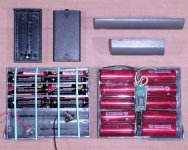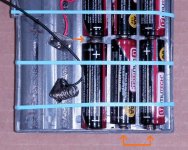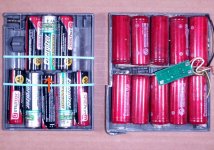Mk.558
Well-known member
Hopefully soon I'll get my tax refund back soon...
In the meantime, I need to start working on acquiring the parts list for my SUPERPOWERDUOTB2. Since I have problems with 7.6.1 and 8.1 on the hard drive and MacTest Pro PPC reports hard drive problems, I think that is an excellent motivator for me to get that 44 pin IDE to CF adaptor. Fortunately, unlike SCSI to IDE adaptors, they are DIRT cheap.
Back to the topic at hand: batteries. We need to be very sure of the battery pack dimensions so that TWO of them will fit inside the Duo's tiny battery pack. This gave me the dimensions: 83mm long x 31mm wide x 17mm high.
So two of those packs would occupy a square area of 83mm by 62mm. The internal ribs will have to be removed by sanding so the packs will all fit. How convenient of them to include wires that mean my lackluster "Ehhhhh" soldering abilities won't get a chance to get too excited. All I'd have to do is intertwist the wires into a series connection, figure out the correct polarity, solder the wires together, put wire caps (or crimp them, which is what I'll probably do), wrap the connection in durable tape, put buffer material inside the battery, reapply glue to the case halves, stuff the packs in there and wait about two days.
Those of you looking to tear up a Duo and "rearrange things better than Apple did" can look at non-chuck batteries. I used to be into Airsoft. (It's not softair, its airsoft.) Non-chuck batteries were used for AEGs (Automatic Electric Guns) that had retracting or folding stocks: with folding stocks like the MP5A3, the battery would go in the front forearm, in folding stock models it might also go in the front forearm OR it might be a special "crane" configuration that fits inside a "crane" stock (kinda like a cross between a full stock and a skeleton stock, aka the SIG 552).
In the meantime, I need to start working on acquiring the parts list for my SUPERPOWERDUOTB2. Since I have problems with 7.6.1 and 8.1 on the hard drive and MacTest Pro PPC reports hard drive problems, I think that is an excellent motivator for me to get that 44 pin IDE to CF adaptor. Fortunately, unlike SCSI to IDE adaptors, they are DIRT cheap.
Back to the topic at hand: batteries. We need to be very sure of the battery pack dimensions so that TWO of them will fit inside the Duo's tiny battery pack. This gave me the dimensions: 83mm long x 31mm wide x 17mm high.
So two of those packs would occupy a square area of 83mm by 62mm. The internal ribs will have to be removed by sanding so the packs will all fit. How convenient of them to include wires that mean my lackluster "Ehhhhh" soldering abilities won't get a chance to get too excited. All I'd have to do is intertwist the wires into a series connection, figure out the correct polarity, solder the wires together, put wire caps (or crimp them, which is what I'll probably do), wrap the connection in durable tape, put buffer material inside the battery, reapply glue to the case halves, stuff the packs in there and wait about two days.
Those of you looking to tear up a Duo and "rearrange things better than Apple did" can look at non-chuck batteries. I used to be into Airsoft. (It's not softair, its airsoft.) Non-chuck batteries were used for AEGs (Automatic Electric Guns) that had retracting or folding stocks: with folding stocks like the MP5A3, the battery would go in the front forearm, in folding stock models it might also go in the front forearm OR it might be a special "crane" configuration that fits inside a "crane" stock (kinda like a cross between a full stock and a skeleton stock, aka the SIG 552).





